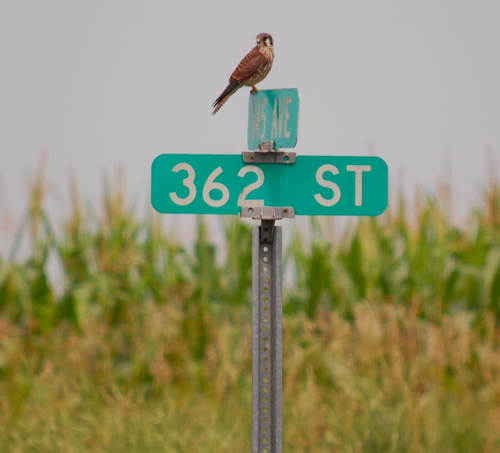
Odd Field Sparrow
I have a sparrow that has been driving me nuts on my surveys the last week. I tried turning it in to every other bird but have finally landed on a field sparrow. The bird perches on a bush that is not part of my survey property, so I can't just walk out. Plus, I'm supposed to be monitoring other birds and can only do so much with a non survey species. Yesterday, I tried playing a field sparrow call to get the bird to fly over. It didn't but a neighboring field sparrow did. Then, I tried playing a clay-colored sparrow call and the bird flew over--and it doesn't sound like a clay-colored at all. So, is this a young field sparrow working on his sound? A really hoarse field sparrow that has been singing like crazy all summer? Or is a hybrid field sparrow/clay-colored sparrow. They have been known to occur. Here's a video of a hybrid singing.
I may have to drive down to the survey area on my own time and see if I can get a photo. The few times the bird has flown by and not hidden itself in foliage, it looked like a field sparrow. Anyway, here are a few videos of the bird singing:
[youtube]http://www.youtube.com/watch?v=cCAuHpFuLPQ[/youtube]
[youtube]http://www.youtube.com/watch?v=Mdl8zHt6CaY[/youtube]
Fledging Flickers
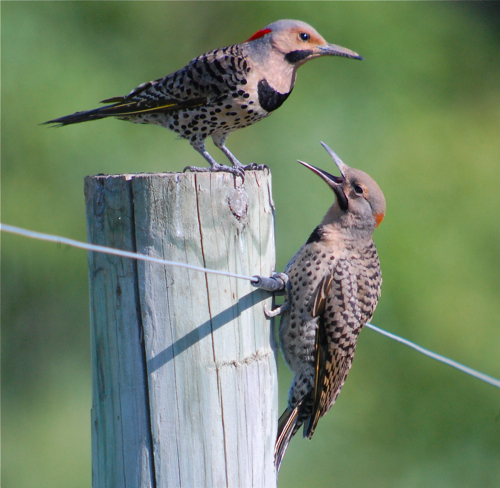 I saw some flickers learning the ways of the world on my bird surveys the other day. Even though that baby looks full grown, he's still hoping to be fed by the adults. Old habits die hard.
I saw some flickers learning the ways of the world on my bird surveys the other day. Even though that baby looks full grown, he's still hoping to be fed by the adults. Old habits die hard.
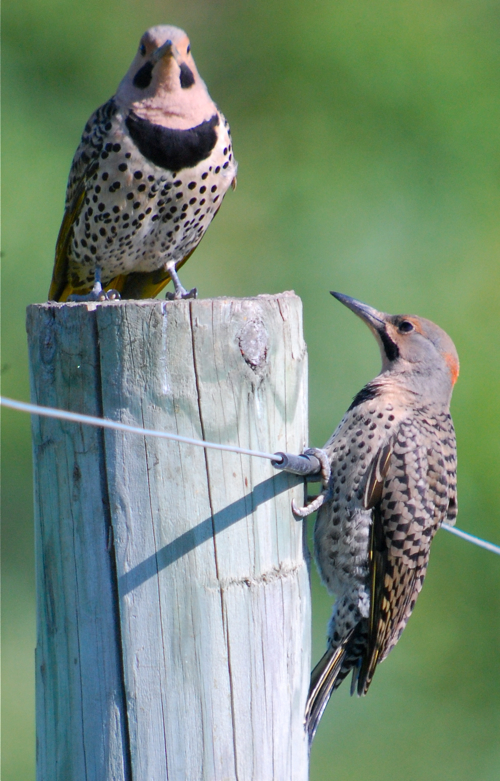
This appears to be a little bit of some father son bonding (they are both male, they both have a mustache).
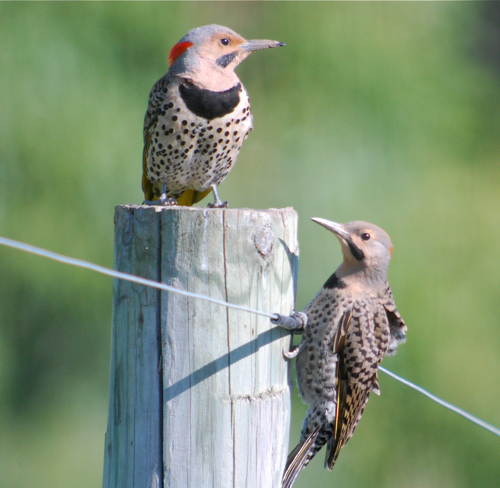
The adult male didn't feed the younger one, but flew off, presumable to teach the younger bird where to forage for food on its own.
The Danger Of A Stake Out Bird
On Monday, a bird call woke me from my sleep. Half asleep I thought, "Why is a robin singing with a cardinal type whistle note?" Something didn't add up. I rolled over and pressed nose to the screen trying to wake up and figure it out. This is not a sound I hear in my Minneapolis neighborhood...so different...so familiar...what does it sound like?
I went to the bathroom and it sounded as though the bird were right outside the window. I stepped over the tub to the window and pished...then saw it--a Carolina wren! Rare for Minnesota and no wonder I couldn't place it in my half awake state. I stream of profanity let loose from my mouth as I tried to figure out how best to document it. My bedroom and bathroom are both the worst for digiscoping. I dashed to my camera. All my noise woke up Non Birding Bill and he asked drowsily, "Wait, what is it, what's wrong?"
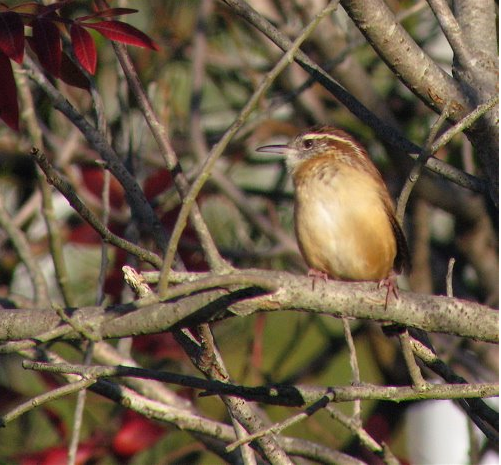
This is not the Carolina wren outside my window, this is one that I took a picture of one in Cape May, NJ. But you get the idea of how distinctive they look.
"Carolina wren outside our window, not supposed to be here," I said searching for an SD card for my camera. By the time I got it, I came into the bedroom to find NBB upright in bed and aiming his iPhone to our window where the bird feeders are. Here's the video he got (you can't see the wren, it's perched just above the feeder, but you can hear it):
[youtube]http://www.youtube.com/watch?v=QQEuDWTiPQ0[/youtube]
Alas, the wren flew off before I could get any kind of photo. I posted the news to my Twitter and Facebook account and then got a couple of messages from local birders telling me that they have either never seen one or at least not in Minnesota and could I let them know if it comes back...panic set in.
The bedroom is by far the MESSIEST room in my apartment--it is the land of laundry and books and the occasional computer part NBB is playing with. I mean, I look at our apartment as a place to sleep between birding trips, not a display of indoor decorating. I can live with people seeing that chaos, but the bedroom? Yikes! Worse yet, there's a whole host of embarrassing things in there. I can't have people in my apartment...at least not the bedroom. The bedroom window is the only window my apartment building allows me to have feeders, the other windows face a paring area and people don't like seed shells and bird poop on their cars, so it's not like I can move the feeders.
Mercifully, the Carolina wren has not returned but I'm still a bit stressed that it could at any moment...
Breathe. You Won't See Every Bird On Earth. A Nyquil Post.
I am a terrible bird watcher. I hate getting up early in the morning. The older I get, the less I care about distinguishing flycatchers (yet, oddly admire those who live for it). I hate birding in the rain--even if it is a life bird that I may never, ever get the chance to see again.

But when I'm forced to get up early in the morning, I'm generally rewarded with cool birds like the above horned lark skulking out on a gravel road above. Rewarded so long as it isn't pouring down rain. I enjoyed having that moment with the horned lark, watching it skulk out of the grasses, keep an eye towards the sky for a an aerial predator and go about its business of being a lark.
As one gets older, I think you take stock of what you can no longer do. I grew up with the notion from my mother that I could do whatever I set my mind to, I think a lot of US kids get that: This baby could grow up to be president, a movie star, a sports star, a Playboy Bunny--or all of them! As you get older, you realize certain things. For example, I remember thinking at my 27 birthday, "Oh wow, I'm too old to pose for Playboy, huh."
But the one thing that hurts the most as I get older is the realization that I won't see every single bird this planet has to offer--no one has. I even get a little down when I realize just based on time and money that I'm not going to be able to visit every country or even every US city the world has to offer. To see all the birds species in the world is a perilous pursuit, just check out the "famous birdwatchers" on the Birdwatching Wikipedia page and it lists all the horrible deaths (and even gang rape) of people who have attempted such a challenge--not to mention some of the bitterness that can come from family as you choose travel over family time. And truth be told, as much as I lament my husband's lack of birding interest, I genuinely enjoy his company and find leaving him behind a big fat bummer.
If time is running out, money is in limited quantity and I can only see so many birds in this lifetime, I do feel much better about not wasting energy on all the flycatchers that look exactly alike and focus on the ones I really find interesting. And, not being a field guide author, the pressure is off for me to care about flycatchers that look the same.

As much as I hate getting up at 4 am, I do appreciate things that force me up at all hours and give me great moments. And more and more, I find myself content to spend time with birds that I've seen several times before but still give me great views. Above is a savannah sparrow that had a nest near where I was stationed. I think that's why digiscoping appeals to me. Sometimes I'll glimpse a brown bird in a gorgeous green background and I want to save that, the green only enhances the subtle beauty of the sparrow.

This pair of savannah sparrows scurried past me several times with beakfuls of squishy bugs for hungry nestlings. I see this species in several states, but I enjoy their familiarity, much the same way I enjoy red-tailed hawks. They also have a sweet, delicated and I fear under appreciated song.

Like the horned lark. This is really a common bird, but many new birders find it evasive and don't realize that the brown bird with black tail stripes they flush as they drive down gravel roads is a potential lifer. But, if you plant yourself on a gravel road, they come out. When you get a chance to see one, they really are striking with the black horns, mask and bib. Horned larks surrounded me not only on the ground, but in the air too. Their territory song serenades me overhead as I note and count certain bird species.

And so I may not get to see every single bird there is out there, but I am content to sleep in as much as I can and smile while a horned lark takes a dust bath in the middle of a gravel road a few feet from where I'm standing.
Stealth Horned Lark
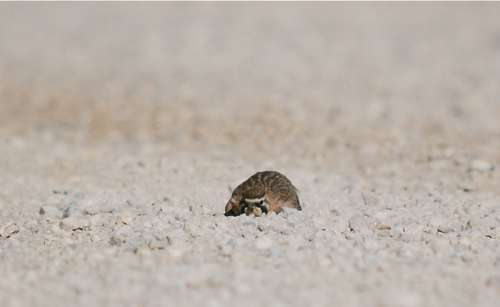 No, Mr. Horned Lark, I can't see you at all. Really.
No, Mr. Horned Lark, I can't see you at all. Really.
Secret Bobolink Conversations #birding
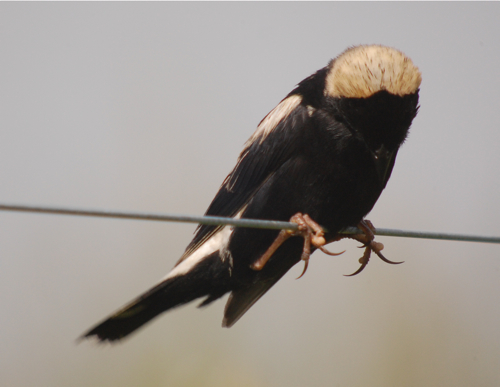
"OMG! My nails are so long! I'm like a cross between Howard Hughes and a red-tailed hawk!"
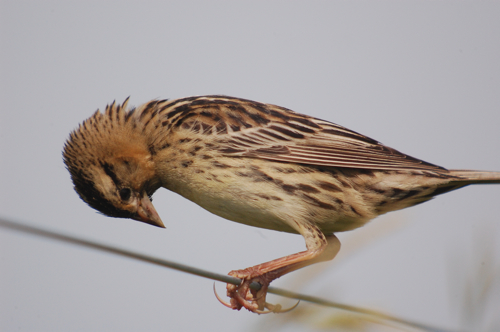 "I know, right?"
"I know, right?"
Bobolinks!
I have to do some work around cows this week.
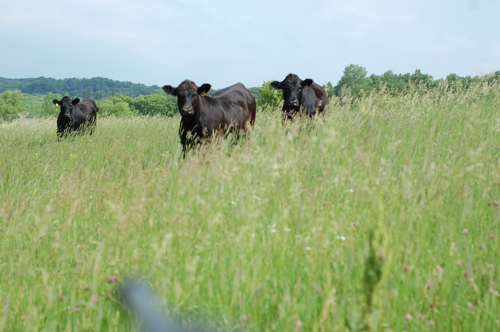
I'm not going to lie, cows make me nervous. Ungulates who stare at you and keep coming towards you are terrifying to me. The only way they could be even scarier would be if they were bison. That is just a lot of animal being controlled by an uncertain brain. These are three of about three dozen cows that were surrounding me. They just kept coming closer and closer with an expectant look. Did they think I had food. If I stepped wards them, they would back away, but some cows in the back of the her would run forward. I tried mooing and that seemed to confuse them even further.
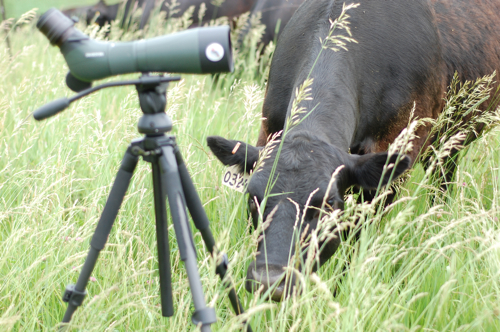
This one was really pushing its luck, "Oy, Bovine, back away from the carbon fiber tripod!" The cows eventually went their way and left me alone, but I think being a five foot tall woman makes me feel uneasy about large cloven hoofed animals getting too close and too curious. Has anyone made a horror movie about cows? If not, they should.
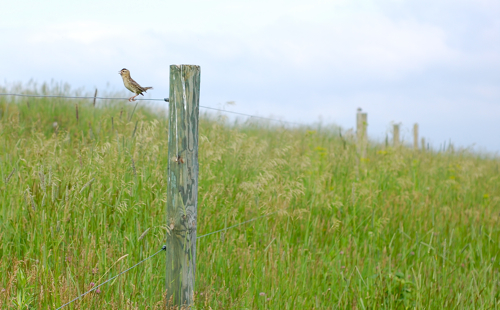
Apart from the stress inducing cows, the big upside to my work this week is that I get to spend time in some of my favorite habitat--open grassland. I'm surrounded by bobolinks, dickcissel, meadowlards and savannah sparrows. Above is a female bobolink who scolded me as I walked to my work area.
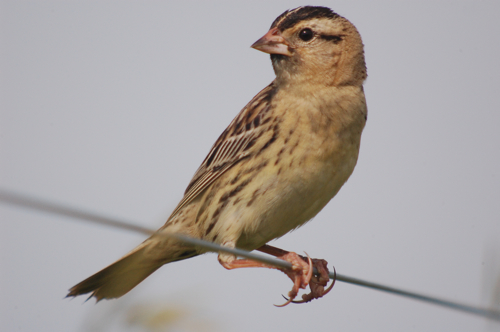
Her brazen attitude on the fence made me realize that she must have had a nest nearby. I made sure to watch where I placed my feet, the last thing I wanted to do was smush little baby bobolinks with my shoes. Female bobolinks are crazy looking birds, they do not look like the males, they look more like sparrows. Technically, bobolinks are considered blackbirds (for the moment, who knows will happen with future taxonomy changes). If you get past the brownish colorization, you can kind of see a blackbird type of shape to these birds (think red-winged blackbird).
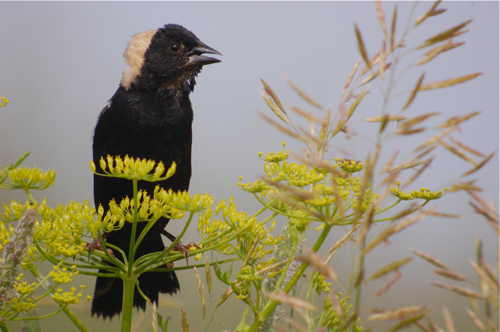
The male wasn't too far behind and flew in to chirp at me, also warning me that I was too close for comfort to his nest. Out of habit, I pished at them and that set the male off in a frenzy of song above me. I paused to listen to that crazy mechanical song. I love that song, it's the general ringtone on my phone. If this make wanted me to move a long, singing his song a few feet above my head was not the way to do it.
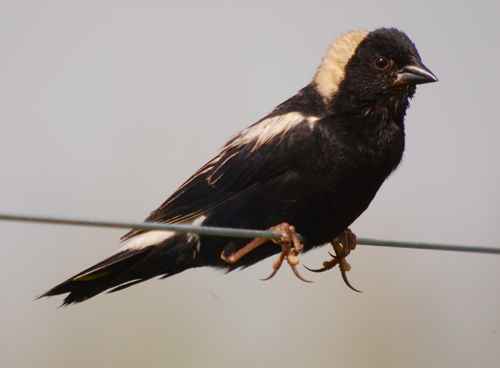
I love everything about these guys. I love their song, their odd plumage (black on the bottom, blond wig on the back of the head, patches of white on the back). This bird is too weird for color tv. And check out those toe nails--they're so long! I love these birds so much, they are worth putting up with a few dozen cows.
Twin Cities Snow Shoeing
I have accepted the snow and have taken to snowshoeing. Partly because my park got a whole bunch of snowshoes this winter and I'm doing some programs one on January 21 and the other on February 19. I need to practice because I have a tendency to walk with my toes out, which inevitably leads to me stepping my shoes and tumbling ass over tea kettle into the snow. I was out with a bunch of rangers at the Minnesota Valley National Wildlife Refuge last week and it was so cool. We found just about every textbook thing you could find on a snowshoe hike: coyote tracks, otter tracks, rodent tracks that end with feather prints and...

...even a fresh antler shed! That's a couple of my fellow rangers in the photo. The antler had six points on it. That's pretty incredible when you consider how deeply this refuge is embedded in the urban Twin Cities. This shed was so fresh, it hadn't been chewed by any mice yet and it still had a bit of blood on the spot where the antler was attached. Too cool! I think it wasn't even an hour old.

After the snowshoe, I hung out at the feeders at the Minnesota Valley National Wildlife Refuge. Check out all the spots of red, the cardinal activity was off the charts. There were even more in the above photo, but at least three were cropped out.

I find comfort in watching the steady stream of activity at bird feeders. Little things like blue jays filling their crops so full with peanuts that you can see the overflow in their open beaks.

I was surprised to see a white-throated sparrow hanging out at the feeders, but for whatever reason, this bird didn't go further south. It's got a good food supply and cover at the refuge. If it can dodge the local sharp-shinned hawk, it just might make it. Here are some other birds visible in the falling snow around the refuge:

Female cardinal (with a female house finch down at the bottom).

Male house finch.
Migration, Carlos Avery and a Pub Quiz
Merlin's Rest put out the call for Guest Pub Quizzers and I'll be leading the Pub Quiz this Sunday, September 19 at 7:30 pm. If you know me and the blog, you have an idea of what kinds of quesitons I'll ask, but I do promise that it will not all be bird related. I'll have some cool prizes...perhaps even some honey from our hives for the winning team.

I keep trying to deny autumn this year and I can't. I took this photo two days ago at Carlos Avery Wildlife Management Area. One can't deny red oak leaves as a sure sign that it's getting colder and the days are getting shorter. My denial was broken in full yesterday when we went on a canoe/kayak paddle in my park for work...it was a tad chilly on the river and my fingers had that dry skin ache that is exclusive to cold, dry air. Sigh. I did get one pleasant reminder of fall--Mr. Neil's housekeeper called to say that they found a 20# patch of Hen of the Woods in our usual patch--my favorite wild edible. We will have some tasty soups and sauces with that fungus this winter!

Canada geese are on the move and I got word that my waterfowl surveys start soon--at the end of the month. My route got expanded this year, but I'm also nervous. I went on a ride along for this new extension last year and the amount of ducks and species mix is a lot to take in. Will I be able to count them all? We'll do our best but I feel this year's survey is of utmost importance. When we do this again for the next few years? Will those numbers change with the Gulf spill? Despite "capping of the well" the spill is not over, there's still a ton of oil in the water, it's below the surface so you can't see it, but it's affecting the food supply.
Of large concern to me is the recent fish kill in Louisiana, Check out This Is Not A Road. Disturbing amount of fish and also interesting that in this fish kill it's several species of fish. I've seen fish kills--we get them along the Mississippi in spring and even on some of our lakes, but it's usually one species of fish. This huge fish kill in Louisiana is SEVERAL species and includes sting rays and a whale. The government says that the oil spill is not the cause even though oil is clearly visible on the fish in close up shots. They official report is depletion of oxygen...which happens this time of year and does cause fish kills but usually not this large and the depletion is caused by the dead zone in the Gulf (created by fertilizer pollution from farmers on the Mississippi River) and most likely exacerbated by the oil and more likely the chemical oil dispersent put in the Gulf). There's a great report on the fish kill from the AP on YouTube and an explanation on New Scientist. I think we'll see more problems.
Sorry for that tangent. I'm not exactly sure what to do about the oil spill. I want people to know that it's still a problem and that many birds (and other coastal creatures, not to mention people's jobs) are in peril, but I don't want this blog to become your daily downer. Just promise me you won't buy into the idea that oil spill is over and we still have problems to solve, 'k?
Back to birds:

There's a feed plot at Carlos Avery and I chuckled at this goldfinch, it was eating the tassels. I know finches are primarily seed eaters and I've recently learned that they eat all matter of plants, but I'm beginning to suspect that there's not a piece of vegetation they won't eat. I do have to hand it to them as far as creativity. You pheasants and your bobwhite go for the corn kernels, goldfinches go tassels. Great way to avoid competition.

Warblers, like the above yellow-rumped warbler were flitting among the tassels too. The appeared to be after tiny insects rather than the plants themselves.

All the grasses and shrubs along the road were alive with small birds. If you could see their shadows rustling among the leaves, you could hear their contact chip notes. A little pishing (for non birders, say the word "pish" only in a loud whisper) made some of them pop up to investigate the sound. Above are some swamp sparrows (the one on the left looks like its still molting heavily).

I love swamp sparrows and they blend so well with the changing fall foliage. I especially love it when see a sparrow head on, they look like cranky old mean with muttonchops. I almost feel like this one should shouting in a wheezy voice, "Hey you, whipper snapper, quit that pishing racket!!" As I was taking their photos, I could hear sandhill cranes calling in the distance and I noticed that they were flying above me:

I would guess that this is a family group of cranes. Perhaps they were doing some laps, getting their wing muscles in shape and teaching the young birds the mysteries of finding a warm column of air spiraling up to glide in. Those thermals save energy when on long journeys.

These cranes are far enough south that they have avoided the Minnesota sandhill crane hunt, but depending on their route, they will have to watch out for the hunts in Kansas and Texas as well. Good luck, cranes.

